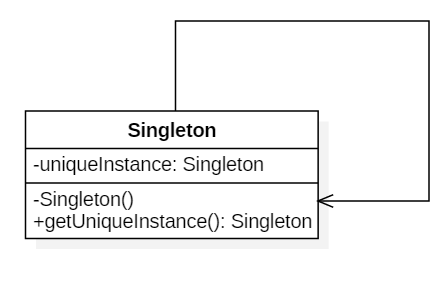 单例
单例
# 单例(Singleton)
# Intent
确保一个类只有一个实例,并提供该实例的全局访问点。
# Class Diagram
使用一个私有构造函数、一个私有静态变量以及一个公有静态函数来实现。
私有构造函数保证了不能通过构造函数来创建对象实例,只能通过公有静态函数返回唯一的私有静态变量。

# Implementation
# Ⅰ 懒汉式-非线程安全
以下实现中,私有静态变量 instance 被延迟实例化,这样做的好处是,如果没有用到该类,那么就不会实例化 instance,从而节约资源。
这个实现在多线程环境下是不安全的,如果多个线程能够同时进入 if (instance == null) ,并且此时 instance 为 null,那么会有多个线程执行 instance = new Singleton(); 语句,这将导致实例化多次 instance。
package com.code.singleton.example1;
public class Singleton {
private static Singleton instance;
private Singleton() { }
public static Singleton getInstance() {
if (instance == null) {
instance = new Singleton();
}
return instance;
}
}
2
3
4
5
6
7
8
9
10
11
12
13
14
15
多线程测试例子
package com.code.singleton.example1;
public class Main {
public static void main(String[] args) {
for(int i = 0; i < 30; i++){
new Thread(new Runnable() {
@Override
public void run() {
Singleton singleton = Singleton.getInstance();
System.out.println("singleton:" + singleton.toString());
}
}).start();
}
}
}
2
3
4
5
6
7
8
9
10
11
12
13
14
15
16
输出结果:
singleton:com.code.singleton.example1.Singleton@ce0f957
singleton:com.code.singleton.example1.Singleton@6fcf47c0
singleton:com.code.singleton.example1.Singleton@ce0f957
singleton:com.code.singleton.example1.Singleton@ce0f957
2
3
4
从结果中可以看出,多线程导致实例化多次 instance,所以为非线程安全单例。
# Ⅱ 饿汉式-线程安全
线程不安全问题主要是由于 instance 被实例化多次,采取直接实例化 instance 的方式就不会产生线程不安全问题。 类创建时生成实例。 但是直接实例化的方式也丢失了延迟实例化带来的节约资源的好处。
package com.code.singleton.example2;
public class Singleton {
private static Singleton instance = new Singleton();
private Singleton() { }
public static Singleton getInstance() {
return instance;
}
}
2
3
4
5
6
7
8
9
10
11
多线程测试例子
package com.code.singleton.example2;
public class Main {
public static void main(String[] args) {
for(int i = 0; i < 30; i++){
new Thread(new Runnable() {
@Override
public void run() {
Singleton singleton = Singleton.getInstance();
System.out.println("singleton:" + singleton.toString());
}
}).start();
}
}
}
2
3
4
5
6
7
8
9
10
11
12
13
14
15
16
# Ⅲ 懒汉式-线程安全
只需要对 getInstance() 方法加锁,那么在一个时间点只能有一个线程能够进入该方法,从而避免了实例化多次 instance。
但是当一个线程进入该方法之后,其它试图进入该方法的线程都必须等待,即使 instance 已经被实例化了。这会让线程阻塞时间过长,因此该方法有性能问题,不推荐使用。
package com.code.singleton.example3;
public class Singleton {
private Singleton() { }
public static synchronized Singleton getInstance() {
if (instance == null) {
instance = new Singleton();
}
return instance;
}
}
2
3
4
5
6
7
8
9
10
11
多线程测试例子
package com.code.singleton.example3;
public class Main {
public static void main(String[] args) {
for(int i = 0; i < 30; i++){
new Thread(new Runnable() {
@Override
public void run() {
Singleton singleton = Singleton.getInstance();
System.out.println("singleton:" + singleton.toString());
}
}).start();
}
}
}
2
3
4
5
6
7
8
9
10
11
12
13
14
15
16
# Ⅳ 双重校验锁-线程安全
instance 只需要被实例化一次,之后就可以直接使用了。加锁操作只需要对实例化那部分的代码进行,只有当 instance 没有被实例化时,才需要进行加锁。
双重校验锁先判断 instance 是否已经被实例化,如果没有被实例化,那么才对实例化语句进行加锁。
package com.code.singleton.example4;
public class Singleton {
private volatile static Singleton instance;
private Singleton() { }
public static Singleton getInstance() {
if (instance == null) {
synchronized (Singleton.class) {
if (instance == null) {
instance = new Singleton();
}
}
}
return instance;
}
}
2
3
4
5
6
7
8
9
10
11
12
13
14
15
16
17
18
多线程测试例子
package com.code.singleton.example4;
public class Main {
public static void main(String[] args) {
for(int i = 0; i < 30; i++){
new Thread(new Runnable() {
@Override
public void run() {
Singleton singleton = Singleton.getInstance();
System.out.println("singleton:" + singleton.toString());
}
}).start();
}
}
}
2
3
4
5
6
7
8
9
10
11
12
13
14
15
16
考虑下面的实现,也就是只使用了一个 if 语句。在 instance == null 的情况下,如果两个线程都执行了 if 语句,那么两个线程都会进入 if 语句块内。虽然在 if 语句块内有加锁操作,但是两个线程都会执行 instance = new Singleton(); 这条语句,只是先后的问题,那么就会进行两次实例化。因此必须使用双重校验锁,也就是需要使用两个 if 语句:第一个 if 语句用来避免 instance 已经被实例化之后的加锁操作,而第二个 if 语句进行了加锁,所以只能有一个线程进入,就不会出现 instance == null 时两个线程同时进行实例化操作。
if (instance == null) {
synchronized (Singleton.class) {
instance = new Singleton();
}
}
2
3
4
5
instance 采用 volatile 关键字修饰也是很有必要的, instance = new Singleton(); 这段代码其实是分为三步执行:
- 为 instance 分配内存空间
- 初始化 instance
- 将 instance 指向分配的内存地址
但是由于 JVM 具有指令重排的特性,执行顺序有可能变成 1>3>2。指令重排在单线程环境下不会出现问题,但是在多线程环境下会导致一个线程获得还没有初始化的实例。例如,线程 T1 执行了 1 和 3,此时 T2 调用 getInstance() 后发现 instance 不为空,因此返回 instance,但此时 instance 还未被初始化。
使用 volatile 可以禁止 JVM 的指令重排,保证在多线程环境下也能正常运行。
# Ⅴ 静态内部类实现
当 Singleton 类被加载时,静态内部类 SingletonHolder 没有被加载进内存。只有当调用 getInstance() 方法从而触发 SingletonHolder.INSTANCE 时 SingletonHolder 才会被加载,此时初始化 INSTANCE 实例,并且 JVM 能确保 INSTANCE 只被实例化一次。
这种方式不仅具有延迟初始化的好处,而且由 JVM 提供了对线程安全的支持。
package com.code.singleton.example5;
public class Singleton {
private Singleton() {}
private static class SingletonHolder {
private static final Singleton INSTANCE = new Singleton();
}
public static Singleton getInstance() {
return SingletonHolder.INSTANCE;
}
}
2
3
4
5
6
7
8
9
10
11
12
13
14
多线程测试例子
package com.code.singleton.example5;
public class Main {
public static void main(String[] args) {
for(int i = 0; i < 30; i++){
new Thread(new Runnable() {
@Override
public void run() {
Singleton singleton = Singleton.getInstance();
System.out.println("singleton:" + singleton.toString());
}
}).start();
}
}
}
2
3
4
5
6
7
8
9
10
11
12
13
14
15
16
# Ⅵ 枚举实现
package com.code.singleton.example6;
public enum Singleton {
INSTANCE;
private String objName;
public String getObjName() {
return objName;
}
public void setObjName(String objName) {
this.objName = objName;
}
}
2
3
4
5
6
7
8
9
10
11
12
13
14
15
16
17
18
19
多线程测试例子
package com.code.singleton.example6;
public class Main {
public static void main(String[] args) {
for(int i = 0; i < 30; i++){
new Thread(new Runnable() {
@Override
public void run() {
// 单例测试
Singleton firstSingleton = Singleton.INSTANCE;
firstSingleton.setObjName("firstSingleton set firstName");
System.out.println(firstSingleton.getObjName());
Singleton secondSingleton = Singleton.INSTANCE;
secondSingleton.setObjName("secondSingleton set secondName");
System.out.println(firstSingleton.getObjName());
System.out.println(secondSingleton.getObjName());
// 反射获取实例测试
try {
Singleton[] enumConstants = Singleton.class.getEnumConstants();
for (Singleton enumConstant : enumConstants) {
System.out.println(enumConstant.getObjName());
}
} catch (Exception e) {
e.printStackTrace();
}
}
}).start();
}
}
}
2
3
4
5
6
7
8
9
10
11
12
13
14
15
16
17
18
19
20
21
22
23
24
25
26
27
28
29
30
31
32
firstSingleton set firstName
secondSingleton set secondName
secondSingleton set secondName
secondSingleton set secondName
firstSingleton set firstName
2
3
4
5
该实现可以防止反射攻击。在其它实现中,通过 setAccessible() 方法可以将私有构造函数的访问级别设置为 public,然后调用构造函数从而实例化对象,如果要防止这种攻击,需要在构造函数中添加防止多次实例化的代码。该实现是由 JVM 保证只会实例化一次,因此不会出现上述的反射攻击。
该实现在多次序列化和序列化之后,不会得到多个实例。而其它实现需要使用 transient 修饰所有字段,并且实现序列化和反序列化的方法。
# Examples
- Logger Classes
- Configuration Classes
- Accesing resources in shared mode
- Factories implemented as Singletons